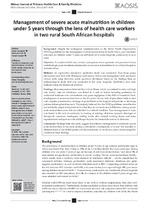| dc.contributor.author | Muzigaba, Moise | |
| dc.contributor.author | van Wyk, Brian | |
| dc.contributor.author | Puoane, Thandi | |
| dc.date.accessioned | 2018-02-05T12:30:08Z | |
| dc.date.available | 2018-02-05T12:30:08Z | |
| dc.date.issued | 2018 | |
| dc.identifier.citation | Muzigaba, M. et al. (2018). Management of severe acute malnutrition in children under 5 years through the lens of health care workers in two rural South African hospitals. African Journal of Primary Health Care and Family Medicine, 10(1): a1547. | en_US |
| dc.identifier.issn | 2071-2936 | |
| dc.identifier.uri | http://dx. doi.org/10.4102/phcfm. v10i1.1547 | |
| dc.identifier.uri | http://hdl.handle.net/10566/3470 | |
| dc.description.abstract | BACKGROUND: Despite the widespread implementation of the World Health Organization
(WHO) guidelines for the management of severe malnutrition in South Africa, poor treatment
outcomes for children under 5 years are still observed in some hospitals, particularly in rural
areas.
OBJECTIVE: To explore health care workers’ perceptions about upstream and proximal factors
contributing to poor treatment outcomes for severe acute malnutrition in two district hospitals
in South Africa.
METHODS: An explorative descriptive qualitative study was conducted. Four focus group
discussions were held with 33 hospital staff (senior clinical and management staff, and junior
clinical staff) using interview guide questions developed based on the findings from an
epidemiological study that was conducted in the same hospitals. Qualitative data were
analysed using the framework analysis.
FINDINGS: Most respondents believed that critical illness, which was related to early and high
case fatality rates on admission, was linked to a web of factors including preference for
traditional medicine over conventional care, gross negligence of the child at household level,
misdiagnosis of severe malnutrition at the first point of care, lack of specialised skills to deal
with complex presentations, shortage of patient beds in the hospital and policies to discharge
patients before optimal recovery. The majority believed that the WHO guidelines were effective
and relatively simple to implement, but that they do not make much difference among severe
acute malnutrition cases that are admitted in a critical condition. Poor management of cases
was linked to the lack of continuity in training of rotating clinicians, sporadic shortages of
therapeutic resources, inadequate staffing levels after normal working hours and some
organisational and system-wide challenges beyond the immediate control of clinicians.
CONCLUSION: Findings from this study suggest that effective management of paediatric severe
acute malnutrition in the study setting is affected by a multiplicity of factors that manifest at
different levels of the health system and the community. A verificatory study is encouraged to
collaborate these findings. | en_US |
| dc.language.iso | en | en_US |
| dc.publisher | AOSIS | en_US |
| dc.rights | © 2018. The Authors.
Licensee: AOSIS. This work
is licensed under the
Creative Commons
Attribution License. | |
| dc.subject | World Health Organization (WHO) guidelines | en_US |
| dc.subject | Malnutrition | en_US |
| dc.subject | Poor treatment outcomes | en_US |
| dc.subject | Children | en_US |
| dc.subject | South Africa | en_US |
| dc.title | Management of severe acute malnutrition in children under 5 years through the lens of health care workers in two rural South African hospitals | en_US |
| dc.type | Article | en_US |
| dc.privacy.showsubmitter | FALSE | |
| dc.status.ispeerreviewed | TRUE | |

